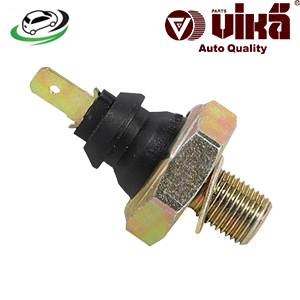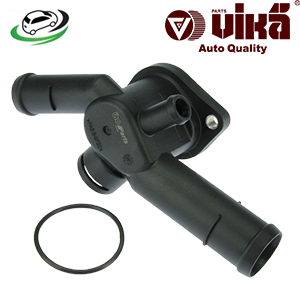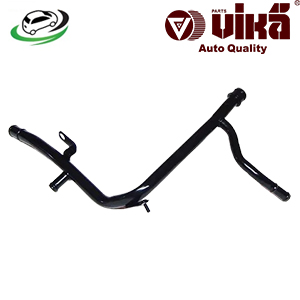-7%
Get Engine Coolant Tube Audi A3 Saloon/Sportback 04-2008 / VW Beetle 1C/Golf 1K/Golf Plus 5M/Jetta/Syncro 16 06A121065DE
The engine coolant tube is an essential component in a vehicle’s cooling system, playing a pivotal role in maintaining optimal engine temperatures. This system ensures that the engine does not overheat during operation by circulating coolant (a mixture of water and antifreeze) throughout the engine block, absorbing and dissipating excess heat. In this detailed exploration, we’ll discuss the design, function, importance, types, common issues, and maintenance of the engine coolant tube.
Design and Function
Design:
- Materials:
- Metal Tubes: Many engine coolant tubes are made from durable metals such as aluminum, stainless steel, or copper. These materials are chosen for their excellent heat conductivity, resistance to corrosion, and ability to withstand high temperatures and pressures within the cooling system.
- Rubber or Silicone Tubes: Some coolant tubes are constructed from high-temperature rubber or silicone, particularly where flexibility is required. These materials are resilient and can handle the constant expansion and contraction caused by temperature changes.
- Plastic Tubes: In modern vehicles, plastic coolant tubes made from high-strength polymers are becoming more common due to their lightweight and cost-effectiveness. However, they must be designed to resist cracking and warping over time.
- Structure:
- Shape and Diameter: The coolant tube’s diameter and shape vary depending on its location and function within the cooling system. Larger tubes are typically used for main coolant passages, while smaller tubes might be used in more confined spaces or for auxiliary systems.
- Fittings and Connectors: Coolant tubes are equipped with various fittings, clamps, and connectors to ensure secure attachment to the radiator, engine block, water pump, and other components. These connections must be leak-proof to maintain the system’s integrity.
Functionality:
- Circulating Coolant:
- Coolant Flow: The primary function of the engine coolant tube is to facilitate the flow of coolant throughout the engine and cooling system. The coolant absorbs heat from the engine as it passes through the engine block, then moves to the radiator where the heat is dissipated into the atmosphere.
- Maintaining Temperature: By circulating coolant, the tube helps regulate the engine’s temperature, ensuring it remains within an optimal range. This prevents overheating, which can cause severe engine damage, and avoids running too cold, which can lead to inefficiencies and increased emissions.
- Pressure Management:
- Withstanding Pressure: The coolant tube must be capable of withstanding the pressures generated by the coolant as it moves through the system. This pressure is created by the water pump, which forces the coolant to flow through the engine, and by the expansion of coolant as it heats up.
- Preventing Leaks: Any failure in the coolant tube, such as a crack or loose connection, can lead to coolant leaks. This not only reduces the efficiency of the cooling system but can also cause the engine to overheat, leading to potential damage.
Importance of the Engine Coolant Tube
- Engine Protection:
- Preventing Overheating: The coolant tube is critical in preventing the engine from overheating. If the engine operates at too high a temperature, it can suffer from reduced performance, increased wear, and, in extreme cases, catastrophic failure due to warped components or blown head gaskets.
- Maintaining Efficiency: An engine that runs at the correct temperature operates more efficiently, producing better fuel economy and lower emissions. The coolant tube plays a key role in maintaining this balance by ensuring proper coolant circulation.
- System Integrity:
- Sealing the System: The engine’s cooling system is a closed loop, meaning that the coolant continuously circulates without escaping the system. The coolant tube, along with other components, helps maintain this closed-loop integrity, ensuring that the coolant remains within the system and does not leak out.
- Supporting Other Components: The coolant tube works in conjunction with other cooling system components such as the radiator, water pump, and thermostat. A failure in the coolant tube can compromise the entire system, leading to cascading failures that affect engine performance and reliability.
- Versatility:
- Multiple Applications: Coolant tubes are used in various parts of the cooling system, including the main coolant passages between the engine and radiator, bypass tubes that allow coolant to circulate even when the thermostat is closed, and heater core tubes that direct hot coolant to the cabin for heating.
- Adaptability: The design of coolant tubes can be adapted to different engine layouts and cooling system configurations. This versatility makes them suitable for a wide range of vehicles, from compact cars to heavy-duty trucks.
Types of Engine Coolant Tubes
- Rigid Tubes:
- Metal Tubes: Rigid metal coolant tubes are common in areas where high strength and heat resistance are required, such as near the engine block or in high-pressure sections of the cooling system. These tubes are typically bolted or clamped into place and offer excellent durability.
- Plastic Tubes: Rigid plastic tubes are lighter and cheaper than metal tubes, making them popular in modern vehicles. However, they must be carefully designed to avoid issues with heat-related expansion and brittleness over time.
- Flexible Hoses:
- Rubber Hoses: Flexible rubber hoses are used where the coolant tube needs to bend or flex to accommodate engine movement or tight spaces. These hoses are reinforced with fabric or wire mesh to withstand pressure and prevent kinking.
- Silicone Hoses: Silicone hoses are more resistant to extreme temperatures and chemicals than rubber hoses, making them ideal for performance vehicles or applications where high heat is a concern.
- Bypass Tubes:
- Thermostat Bypass: Bypass tubes allow coolant to circulate through the engine even when the thermostat is closed, helping the engine warm up more quickly and preventing localized overheating.
- Auxiliary Bypass: In some systems, additional bypass tubes are used to direct coolant to specific components, such as the turbocharger or oil cooler, to provide additional cooling where needed.
Common Issues with Engine Coolant Tubes
- Leaks:
- Cracks and Splits: Over time, coolant tubes can develop cracks or splits due to exposure to high temperatures, pressure fluctuations, and vibrations. Metal tubes may corrode or crack, while rubber hoses can become brittle and split.
- Loose Connections: Clamps or fittings that secure the coolant tube can loosen over time, especially if not properly installed or if the vehicle experiences significant vibration. Loose connections can lead to leaks and loss of coolant, which may cause the engine to overheat.
- Blockages:
- Sediment Build-up: Contaminants or sediment in the coolant can accumulate inside the tubes, leading to blockages that restrict coolant flow. This can cause uneven cooling and potential overheating of certain engine areas.
- Kinks in Flexible Hoses: Improper installation or routing of flexible coolant hoses can result in kinks that restrict the flow of coolant. Kinks can also develop over time as the hose ages and loses its flexibility.
- Degradation:
- Aging Materials: Rubber hoses and plastic tubes can degrade over time due to exposure to heat, chemicals, and pressure. This degradation can lead to brittleness, cracking, and eventual failure.
- Corrosion: Metal coolant tubes are susceptible to corrosion, especially if the coolant is not regularly changed or if the cooling system is exposed to air. Corrosion can weaken the tube, leading to leaks or complete failure.
Maintenance and Inspection
- Regular Inspection:
- Visual Checks: Periodically inspect the coolant tubes for signs of wear, leaks, or damage. Look for visible cracks, splits, or corrosion, and check the condition of the hose clamps or fittings.
- Check Coolant Levels: Regularly check the coolant level in the radiator and overflow tank. A sudden drop in coolant level may indicate a leak in the coolant tube or another part of the cooling system.
- Coolant Changes:
- Flush the System: Regularly flushing the cooling system helps remove contaminants and sediment that can cause blockages or corrosion in the coolant tubes. Follow the vehicle manufacturer’s recommended intervals for coolant changes.
- Use the Correct Coolant: Always use the type of coolant specified by the vehicle manufacturer. Using the wrong coolant can lead to chemical reactions that degrade the coolant tubes and other cooling system components.
- Replacement Intervals:
- Follow Manufacturer’s Recommendations: Replace coolant tubes and hoses according to the manufacturer’s recommended intervals, or sooner if any signs of wear or damage are detected.
- Proactive Replacement: If you notice any signs of aging or wear during an inspection, replace the coolant tube proactively to avoid sudden failures that could lead to engine overheating.
- Proper Installation:
- Avoid Kinks: When installing flexible hoses, ensure they are routed correctly to avoid kinks that can restrict coolant flow. Use proper clamps and fittings to secure the tubes in place.
- Torque Specifications: Follow the manufacturer’s torque specifications when tightening clamps and fittings to ensure a secure, leak-free connection without damaging the tube.
Follow us on Facebook for more parts.





